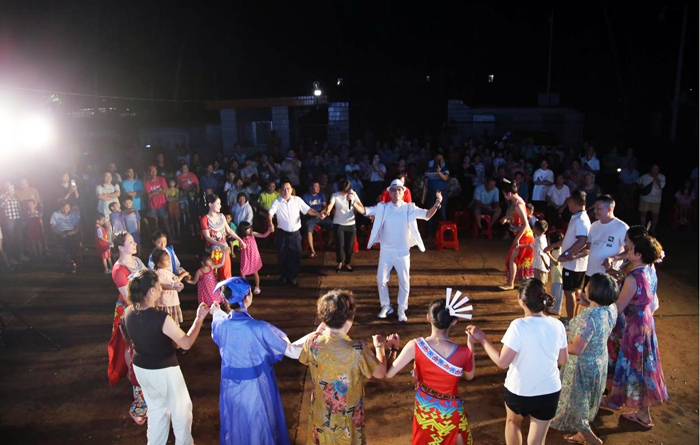 Danzhou Diaosheng, or Danzhou Rhyming Sounds, is a traditional song-and-dance form that originates in the city of Danzhou.[Photo/People.cn]
Danzhou Diaosheng, or Danzhou Rhyming Sounds, is a traditional song-and-dance form that originates in the city of Danzhou.[Photo/People.cn]
With dynamic music and catchy lyrics, singers battle each other on stage, in performances that echo modern-day rap. Except that this is something much older and with very different roots.
In South China's Hainan province, Danzhou Diaosheng, or Danzhou Rhyming Sounds, is a traditional song-and-dance form that originates in the city of Danzhou. Nicknamed "slow rap" by locals because of its slower rhythm, this national intangible cultural heritage dates back over 2,000 years to the ancient Western Han Dynasty (202 BC-25 AD), but still enjoys popularity today.
"The music makes you happy because the melodies are cheerful. When you're feeling sulky, singing it can help dispel the negative mood," said Tang Baoshan, a local inheritor of Danzhou Diaosheng, explaining why it is popular.
"Sometimes people sing the same songs for hours," he added.
Locals hold competitions and stage performances, often with no limit placed on the number of participants, from a dozen to tens of thousands of people. "The scenes are quite spectacular, and everyone wants to win their rap battle," said Tang.
Tang, 75, started learning the folk songs when he was a child. He soon demonstrated a talent for the form.
Later he found a job at a local quarry, where he used to sing while working. Encouraged by his colleagues, Tang began composing songs in 1976, at least 13 of which won local prizes. Three years later, he won the Danzhou Diaosheng competition and rose to fame.
However, as time passed, he saw fewer young people willing to learn the art. "I used to earn a living by singing the Danzhou Diaosheng," Tang recalled. "For the younger people, however, the income was too low to attract them."
In 2006, Danzhou Diaosheng was included in the first national intangible cultural heritage list. In order to rescue the art, Tang joined with local experts to compile a book of the songs they found by knocking on doors in local communities. More than 1,000 songs were recorded.
Also, the city of Danzhou has incorporated the art form into the curriculum of primary schools, hosted art and cultural events featuring Danzhou Diaosheng, and promoted it in tourist attractions.
Social media has also helped popularize the ancient art. During the COVID-19 pandemic, Tang composed a rap song calling on people to protect themselves, and it went viral online.
Thanks to these various efforts, about 85 percent of the residents of Danzhou are familiar with and love Danzhou Diaosheng. Each of the 16 townships is home to at least three troupes, with the city boasting more than 140 troupes of 20 or more members.
"Danzhou Diaosheng has developed very well, and every village has a big Diaosheng team," Tang said, adding that on the occasion of festivals, worships or marriages, people stage large-scale Diaosheng performances, with men and women standing on both sides and singing against each other.
Tang himself directs around 100 Danzhou Diaosheng operas each year, with no less than 250 performances staged, attracting an audience of tens of millions. He has also trained more than 100 rappers, actors and actresses, bringing the art to each and every village.
Nowadays, Danzhou Diaosheng has become a pastime for local people. Tang noted that in the future, he will compose not only in the local dialect, but also in Mandarin and English, thereby allowing more people to enjoy it.
"Danzhou Diaosheng has thousands of years of history, and it is an inseparable part of our Danzhou culture and will never be erased, because people pass it down from generation to generation," Tang said. "We will make it better, and pass it on well."





